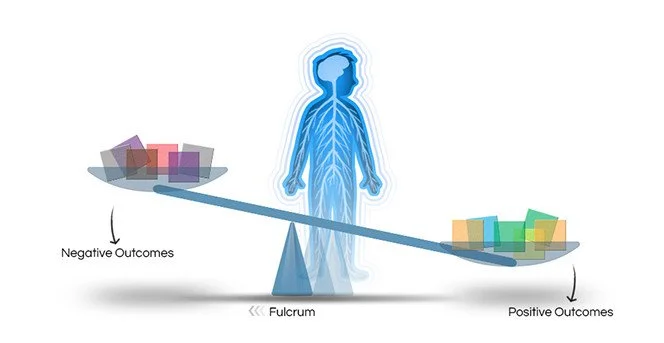
What are ACEs?
Adverse Childhood Experiences (ACEs)
Adverse Childhood Experiences (ACEs) come in many forms, from physical and mental abuse to neglect and household dysfunction. In 1998, CDC-Kaiser Permanente published a groundbreaking study that investigated the impact of ACEs on physical and mental health problems in over 17,000 adults. During the study, the adults were given a survey asking about 10 different types of ACEs and if they had experienced them prior to the age of 18. The study showed a direct correlation between ACEs and future health complications.1
Since this study, we’ve not only learned more about the psychological effects of ACEs on young minds, but also the long-term health complications that can come from recurring exposure to ACEs. Now that we understand how toxic stress affects the minds and bodies of children, we can interrupt these changes by providing safe, stable, nurturing environments, while helping children build social-emotional skills and resilience.
10 ACEs, as identified by the CDC-Kaiser study:
ABUSE
Physical
Physical
Mental Illness
Substance Abuse
Emotional
Incarcerated
Relative
Sexual
NEGLECT
Emotional
HOUSEHOLD DYSFUNCTION
Mother Treated Violently
Divorce
There are other types of adverse childhood experiences not included in the list of 10 ACEs above, including community and environmental ACEs such as racism, bullying and community violence. Researchers have begun to include these experiences as ACEs, too, because they create the same biologic changes as the original 10 ACEs.
Additional resources with examples of these expanded ACEs are:
How are ACEs measured?
You can download and fill out the questionnaire below to get your own ACEs score. For more information on what your ACEs score can tell you, click here.
ACEs can get under our skin, impacting health through toxic stress.
Not all stress is bad. Some stress is healthy and positive because it prepares us to respond to temporary challenges in our lives, such as running a race, public speaking, or starting a new job. Our stress response activates and then quickly returns to baseline. More intense or longer lasting stressors can be tolerable if we have support systems in our lives to help us cope. If we don’t have supports, severe or frequent exposure to certain types of stress can have a ‘toxic’ effect on the body and brain.
Positive
Stress
The body’s normal and healthy stress response to a tense situation/event.
Tolerable
Stress
Activation of the body’s stress response to a long-lasting or severe situation/event.
Examples:
Positive Stress: First day of school or work.
Tolerable Stress: Loss of a family member, but with supportive buffers in place.
Toxic Stress: Witnessing domestic violence in the home, chronic neglect.
The effect of toxic stress on the brain.
Sustained activation of the body’s stress response, toxic stress, impacts many of the brain’s vital systems, including but not limited to:
THE STRESS PATHWAY – Dysregulated HPA Axis, decreased hippocampal volume: leads to anxiety, depression and impaired learning and memory.
EMOTIONAL PROCESSING AND REGULATION – Decreased gray matter in the prefrontal cortex (PFC) and increased amygdala volume leads to hypervigilance and reduced attentional control.
EVALUATION OF REWARD – Decreased reward response in ventral striatum leads to anhedonia, the difficulty in experiencing joy.
BRAIN CONNECTIVITY – Disrupted amygdala to ventromedial PFC pathway, decreased activity in the default mode network, and increased activity in salience networks leads to difficulty understanding the relevance of situations and how to respond.3
Toxic
Stress
Prolonged activation of the body’s stress response to frequent, intense situations/events.
It is this toxic stress that, when not properly addressed and reduced, can lead to long-term behavior issues, health complications, and diseases that are caused by ACEs.
The lifelong (and generational) risks of toxic stress.
Toxic stress also affects children as they grow older, and leads to many common health and behavioral issues later in life.4 The CDC-Kasier ACE study found that adults with an ACE score of 4 or more were at significantly greater risk for many behavioral, physical, and mental health issues later in life.
BEHAVIORAL
Smoking
Severe Obesity
Suicide Attempts
Alcohol Abuse
Depression
Lack of Physical Activity
PHYSICAL & MENTAL HEALTH
Diabetes
STDs
Drug Use
The effects of toxic stress on epigenetics
Genes are the blueprint that provide instructions for making proteins in our bodies. All processes that make us human require these proteins and help to define who we are. Epigenetics describes the way that our genes are turned on and off – whether a specific gene is used or not. We now know that what we experience in life changes our epigenetic profile, or in other words, life experience changes our genes – really getting under our skin. Not only does this affect the individual, the way our bodies respond to stress can be passed from one generation to the next through our genes.5
Stroke
Chronic Lung Disease
Cancer
Heart Disease
Broken Bones
Missing Work
Ways to prevent toxic stress:
Provide a nurturing, safe, and stable environment.
Help children learn to cope with adversity.
Reduce a child’s ACE exposure.
ACEs work through experience, not just exposure. Exposure alone doesn’t necessarily mean a child is affected. If the ACE is prevented from causing toxic stress, the harm should not occur. With a caring and nurturing environment, we can build children with the resilience to protect them from ACEs.
Resilience: our brains are malleable
Resilience is the ability to thrive, adapt, and cope despite tough and stressful times, and is an ideal counterbalance to ACEs.6
Resilience tips the scale toward healthy
According to the Center on the Developing Child at Harvard University, one way to understand the development of resilience is to visualize a balance scale. Protective experiences and coping skills on one side counterbalance significant adversity on the other. Resilience is evident when a child’s health and development tips toward positive outcomes — even when a heavy load of factors is stacked on the negative outcome side.
Seven core ideas to help develop and foster resilience in children:
Competence – Building their understanding of their skills.
Confidence – Helping kids grow a true belief in their own abilities.
Connection – Connecting children with other people, schools and communities to further build their support system.
Character – Helping them comprehend a clear sense of right and wrong, and teaching them moral values.
Contribution – Offering children a chance to contribute to the well-being of others. They learn that giving service feels good and then feel more confident to ask others for help as well.
Coping – Discovering a variety of healthy coping strategies to prevent children from dangerous “quick fixes” to stress.
Control – Teaching children to make decisions on their own so they can experience a sense of control.
To explore these 7Cs in more detail, click here.
Additional ways to promote resilience:
Acknowledge the child’s experience of ACEs and how it may be influencing their behavior – reframing “What’s wrong with you?” to “What happened to you?”
Help children identify their emotions, talk about them, and express them appropriately.
Empower children to problem solve and work through their issue/problem.
Promote healthy coping habits of meditation and mindfulness, exercise, and sleep routines.
Build my understanding and empathy
When working with others who may have experienced ACEs, consider the following:
What ACEs have you possibly experienced?
How have ACEs impacted your life (physically, emotionally, professionally)?
What internal and external support helped you deal with your ACEs?
How have your ACEs impacted your ability (both positively and/or negatively) to help others as they cope with their own ACEs?
Working together to build better outcomes.
We all have a role to play in providing better futures for children. No matter where you live or who you are, you can play a role in building better outcomes. To learn more, explore our audience-specific guides below about how ACEs and fostering resilience can help change the future for children.
- Felitti, V.J., Anda, R.F., Nordenberg, D., Williamson, D.F., Spitz, A.M., Edwards, V., & Koss, M. P. (1998) Relationship of childhood abuse and household dysfunction to many of the leading causes of death in adults: The Adverse Childhood Experiences (ACE) Study. American journal of Preventive Medicine 14(4), 245-258
- Shonkoff, Jack P. Andrew S. Garner. “The Lifelong Effects of Early Childhood Adversity and Toxic Stress.” Pediatrics: Official Journal of the American Academy of Pediatrics. December 26, 2011.
- Shonkoff, Jack P. Andrew S. Garner. “The Lifelong Effects of Early Childhood Adversity and Toxic Stress.” Pediatrics: Official Journal of the American Academy of Pediatrics. December 26, 2011.
- http://www.rwjf.org
- Shonkoff, J. P. & Garner, A.S. (2012). The Lifelong Effects of Early Childhood Adversity and Toxic Stress. Pediatrics: Official Journal of the American Academy of Pediatrics, 129(1), e232–e246.
- Prevent Child Abuse America, KPJR Films. “The Facilitator’s Guide to Resilience.”
- Ginsburg, K. R., & Kinsman, S.B. (2014) Reaching Teens: Strength-based Communication Strategies to Build Resilience and Support Healthy Adolescent Development. American Academy of Pediatrics.




